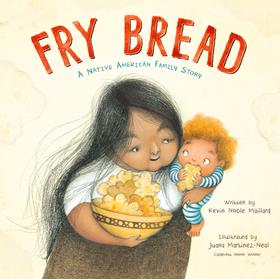
|
|
| Juana Martinez-Neal (photo: Jade Beall) |
|
Last week, Juana Martinez-Neal won the Robert F. Sibert Medal for "the most distinguished informational book published in the United States in English" for her picture book Fry Bread: A Native American Family Story, written by Kevin Noble Maillard and published by Roaring Brook Press.
In 2018, you won the Pura Belpré Illustrator Award for La Princesa and the Pea (Putnam), written by Susan Middleton Elya. In 2019, you received a Caldecott Honor for Alma and How She Got Her Name (Candlewick), your first solo picture book. Now, in 2020, Fry Bread won the Robert F. Sibert Medal and was also one of the Honor titles of the American Indian Youth Literature Award. That's a pretty big past few years! How are you feeling?
Excited, grateful, satisfied and more, much more. It is unbelievable to be awarded in different areas of children's literature. Starting with the Pura Belpré celebrating Latinx culture in the U.S., then the Caldecott Honor and now the Sibert for the best informational book in the U.S. It is a very nice culmination for all the years I worked towards first becoming published.
Why did you want to illustrate Fry Bread? What drew you to the picture book?
Its words. They are so powerful and moving. The first time I read the manuscript, it moved me to tears. I had to read it over and over again. Each time I read, it was clearer that I had to illustrate this book. As a person of color and Peruvian, I could connect with so many aspects of the book.
When I read the "Fry Bread is history" stanza, I was overwhelmed with emotion. I could see this spread as where I could include storytelling, which is such an important aspect of Indigenous life throughout the Americas. In my illustration, the grandparents are sharing the history of the removal of their people with the children in the family. This combination of the words and images is uncomfortable, yet it is important to share with young readers.
How did you work to connect your illustrations to Maillard's deeply personal text? Were there things you incorporated in the art that nodded to the emotional aspects of his writing?
I can only illustrate words I understand and deeply connect with. Being born and raised in Peru, I could see the experiences of the Indigenous people of Peru also reflected in Kevin's words about the experiences of American Indians.
At the same time, I am always very conscious of how easy it is to stereotype what Peruvians look like in children's books and all media (when in reality we look many different ways).
One concept of the book I loved is the gathering together to share a meal. I knew that well since I had similar experiences growing up in Peru. We get together to share time, cook, eat, catch up, relax and eat some more. When I began to work on the book, I found myself adding more and more characters and with that the family kept growing and growing. With each family member, I hoped to depict a contemporary Native American family.
 What about the more historical aspects of the text? How did you work with those?
What about the more historical aspects of the text? How did you work with those?
You bring up a great point. The spread of "Fry Bread is history" was the most challenging. Because of the words that accompany the illustration, the spread needed to have some surreal elements. At the same time, it had to continue with what we had established in all the other spreads in the book: that this book was current and strongly tied to reality. My editor, Connie [Hsu], pushed me for more in this spread. With the image of the grandparents storytelling, I added the crows and the people walking in the background to signify the removal and displacement of Native Americans.
Did you know how you wanted this book to look from the very beginning? Or did it change the more you worked on it?
I knew early on that I wanted to represent a current-day Seminole family and include a wide range of skin tones in the characters. Kevin shared photographs, videos and resources to help me represent the family. With Kevin's collaboration, I was able to bring to the work even the smallest of details: the bowl the grandma uses to prepare the dough, the dad's tattoos, the pattern on the aunt's skirt, the baskets and dolls and so much more.
How do you feel about this title winning the Sibert Medal? Did you consider Fry Bread an "informational book"?
It is such a huge honor! I feel happy and proud that this book received both the Sibert Medal and the American Indian Youth Literature Award Picture Book Honor. Fry Bread was a true collaboration which presents information in a more untraditional way. Information is presented in the author's note, and also in the book itself through the art and words starting with the endpapers.
Is there anything else you'd like to tell Shelf Awareness readers?
Fry Bread is a book for everyone to share--I hope it will start important and necessary conversations for all readers. --Siân Gaetano, children's and YA editor, Shelf Awareness

